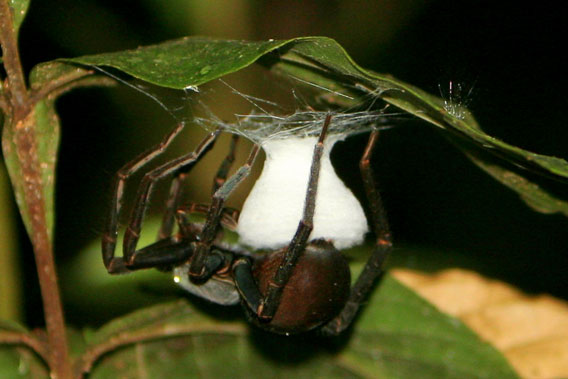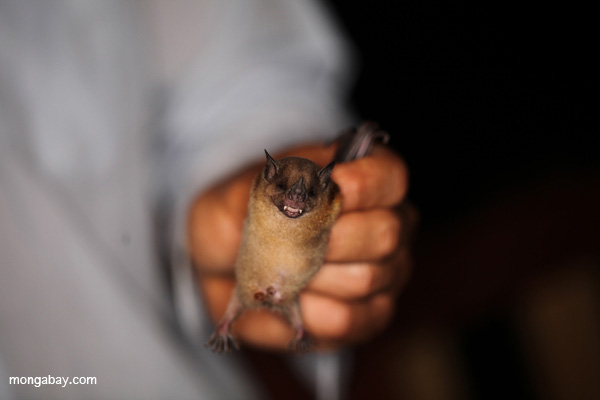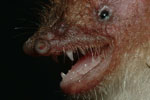Everyone loves the beautiful animals, the playful orangutans, the rolly-polly pandas, the regal tigers, the wise elephants, the awe-inspiring whales, the silly penguins—and it shows. Aside from gracing calendars and starring in movies, these species receive millions in conservation funds and have no shortage of researchers devoted to them. But what about the ugly, crawly, shiver-inducing species? What about those animals that crawl instead of bound,that are slimy instead of furry, that inhabit the deep dark place of the world. Many of the world’s least appreciated, most maligned species are actually hugely important to ecosystems. In addition, given little-conservation attention (or research) some of these species could vanish without us even realizing it.
What better day to celebrate—yes, celebrate—the creepy-crawlies of the world than Halloween and perhaps give some of Nature’s frightful species some well-deserved publicity.

A tarantula laying eggs at night in the Ecuadorian Amazon. Among the world largest spiders, the 900 or so species of tarantula face a variety of threats, but habitat loss is probably the biggest. Photo by: Jeremy Hance.

A freshwater fish from Brazil known as Chafalote (Rhaphiodon vulpinus) with teeth to rival a vampires. Freshwater Amazonian fish are imperiled by overexploitation as well as plans for massive hydroelectric projects throughout the Amazon. Photo by: Rhett A. Butler.

Cockroaches swarm a cave in Malaysia. Unloved by many, it should be noted that only about 4 species of cockroach are considered pests out of over 4,000 documented species. Photo by: Jeremy Hance.

A venomous tree viper native to Sumatra. Given widespread deforestation in Sumatra, this species may be imperiled. Photo by: Rhett A. Butler.

A Madagascar Fire Millipede: while millipedes may put some people off, they are important decomposers, helping ecosystems clean-up after themselves. Photo by: Rhett A. Butler.
A tiger leech in Malaysia. While often detested, leeches have proven useful in medicine for millennia up to the present-day. Photo by: Rhett A. Butler.

Vultures, like this one in Tanzania, may not be the prettiest of birds, but they are incredibly efficient at taking care of corpses, which could otherwise spread disease. Many species of vultures have plummeted recently due to poisoning from cattle drugs. Photo by: Rhett A. Butler.
Not so scary as dirty: a dung beetle rolls up its meal in Malaysia. Despite their unfortunate name, dung beetles play a massive role in recycling nutrients and improving soils. Photo by: Rhett A. Butler.

Many, many people fear bats (not like this researcher in Peru), but bats play a number of vital roles in ecosystems, from dispersing seeds to pest control. Still, many species are threatened by deforestation and disease. Photo by: Rhett A. Butler.

Probably the scariest species in the world are not snakes or spiders, but the mosquitos that spread malaria in the tropics (like this mosquito in New Guinea). Nearly a million people die from malaria annually, making up some 2.23 percent of deaths worldwide. Photo by: Rhett A. Butler.

The world’s scariest species for Halloween? Yes, it’s us. Even mosquitoes don’t kill people like people do. In the 20th Century, wars alone likely killed more people than malaria. This is a photo of armed men in Indonesian New Guinea. Photo by: Rhett A. Butler.
Related articles

Photos: three bizarre bats discovered in Southeast Asia
(10/30/2011) In the forests of Cambodia and Vietnam, researchers have discovered three new species of tube-nosed bats, known for extraordinary nostrils that look like blooming flowers. The new bats, described in the Journal of Mammalogy, are likely imperiled by deforestation. “They all possess specially shaped nostrils (hence the name for the group) the exact role of which not known yet,” Gabor Csorba, lead author of the paper with the Hungarian Natural History Museum, told mongabay.com.
Romney joins climate change denier camp?
(10/28/2011) Presidential hopeful Mitt Romney reversed his position on the underlying drivers of recent climate climate change, stating “we don’t know what’s causing climate change,” reports ThinkProgress.org.
Animal picture of the day: Halloween frog mounts pumpkin
(10/27/2011) A Halloween enrichment exercise for a giant monkey frog at ZSL London.